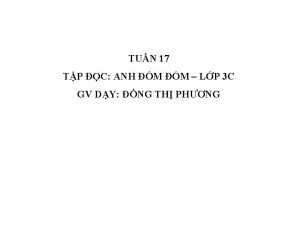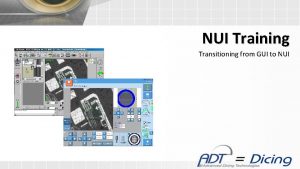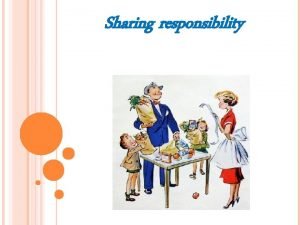Leadership Knowledge Sharing Innovation Implications for Performance NUI






































- Slides: 38

Leadership, Knowledge Sharing & Innovation: Implications for Performance NUI Galway Maura. Sheehan@nuigalway. ie School of Business & Economics

Context • Among resources and capabilities that may help organisations obtain competitive advantage, knowledge is a key strategic resource. • External and internal knowledge activities are widely recognised as indicators of knowledge flow that are central to innovation (e. g. , Damanpour, 1991; von Krogh, Ichijo and Nonaka, 2000). • Yet, to date there has been little research aimed at understanding how leader behaviours encourage, support and enhance knowledge sharing (see Carmeli et al. , 2013; Nonaka & Toyama, 2005 for notable exceptions). School of Business & Economics

Context • This research links the knowledge sharing and leadership literatures to the innovation of firm performance literatures. • Specifically, set within a dynamic capabilities framework, whether leader behaviours enhance knowledge sharing; whether knowledge sharing is positively associated with innovation; and whether innovation is positively associated with performance is examined. • A multiple respondent, longitudinal database is used to examine these relationships. • These relationships are examined within domestic and overseas subsidiaries of UK owned MNCs. The overseas subsidiaries are located in Czech Republic, Hungary & Poland. School of Business & Economics

Context • Knowledge sharing/exchange is understood here to refer to activities aimed at transferring or disseminating knowledge from one person or group to another (Lee, 2001). • Specifically, focus is given to implicit or tacit work experience that is shared and exchanged between employees within the workforce (internal knowledge sharing) and with colleagues outside of the employees’ organisation (external knowledge sharing). • The knowledge sharing measures are adapted from Lee (2001) & Lu et al. (2006). • Leadership & knowledge exchange/sharing measures adapted from Carmeli & Waldman (2010); Connelly & Kelloway (2003). • See Tables in Appendix of hand-out for further detail. School of Business & Economics

Theoretical Framework: Leader Behaviours and Knowledge Sharing • Drawing upon Carmeli et al. ’s (2013) work, it is posited that leaders who support knowledge sharing and collaborative behaviours and encourage information exchange, openness and idea sharing are more likely to motivate their employees to share and exchange knowledge with others within and outside the organisation. Thus, it is posited that: Hypothesis 1(a): Leader behaviours which promote knowledge exchange (“pro knowledge exchange leadership behaviours”) are positively related to internal knowledge sharing; Hypothesis 1(b): Leader behaviours which promote knowledge exchange (“pro knowledge exchange leadership behaviours”) are positively related to external knowledge sharing. School of Business & Economics

Theoretical Framework: Knowledge Sharing and Innovation • Sharing knowledge enables the capture of existing knowledge basis both within and outside the organisation. • Potential to enhance the development and introduction of new products and services and new processes within the organisation (Nonaka and Takeuchi, 1995; Wand Noe, 2010). • If knowledge is not shared, however, experience and expertise will not be utilised to their full potential (Hansen, 199; 2002). School of Business & Economics

Theoretical Framework: Knowledge Sharing and Innovation • Yahoo’s CEO’s recent highly unpopular policy of banning all working from home to enable better “communication and collaboration” which she believes will be generated by employees working side-by-side shows the importance given to knowledge sharing – as well as the role of leadership in directing this sharing - in practice. • It is, therefore, plausible that there will be a direct impact of pro knowledge sharing leader behaviours on innovation. School of Business & Economics

Theoretical Framework: Knowledge Sharing and Innovation • Indeed, the leader plays a critical role in generating innovation (Tushman and Nadler, 1986) and is pivotal in creating a climate that encourages the abilities and management practices to sustain innovation. Thus: Hypothesis 2: There will be a positive association (direct) between pro knowledge sharing leader behaviours and (a) innovation and (b) innovation intensity. School of Business & Economics

Theoretical Framework: Knowledge Sharing and Innovation • Studies that have examined knowledge and information sharing find evidence that both internal and external knowledge sharing are important for increased innovation (Ancona and Caldwell, 1992 (external sharing); Monge, Cozzens and Cotractor, 1992 (internal sharing); Troy, Szymanski and Rajan, 2001 (both types)). It is therefore posited that: • Hypothesis 3(a): Internal knowledge sharing is positively associated with innovation. • Hypothesis 3(b): External knowledge sharing is positively associated with innovation. School of Business & Economics

Theoretical Framework: Knowledge Sharing and Innovation • It is also likely that pro knowledge sharing behaviours can interact positively with both internal and external knowledge sharing to enhance innovation: Hypothesis 4: Pro knowledge sharing leader behaviours and knowledge (both (a) internal and (b) external) sharing interact to positively influence innovation. School of Business & Economics

Theoretical Framework: Innovation and Performance • While a better understanding of factors that enhance innovation is valuable, it is absolutely critical to examine whether innovation – particularly prior innovation – impacts positively on organisational performance. • Previous studies have indeed found that innovation contributes to positively to organisational performance (Capon et al. , 1992; Damanpour, 1991; Garcia-Morales et al. , 2008; Lopez-Cabrales et al, 2009; Perez-Luno et al. , 2007). School of Business & Economics

Theoretical Framework: Innovation and Performance • This reflects, in part, innovator’s ability to create, expand revitalise markets and to influence, and even change, consumer preferences and behaviour (Zhou, 2006). It is thus posited that: Hypotheses 5: Both measures of prior innovation (innovation and intensity) (2006 -2009) are positively associated with subsidiary performance (financial and labour productivity) (2010 -2012). School of Business & Economics

Theoretical Framework: Innovation and Performance • It is also plausible that knowledge transfer and pro knowledge sharing leader behaviours, and their interaction, can have a direct impact on performance (Barney and Wright’s (1998); Lepak and Snell, 2002, p. 519). The final hypothesis is: Hypothesis 6(a): There will be a positisve association (direct) between pro knowledge sharing leader behaviours and subsidiary performance; Hypothesis 6(b): Internal knowledge sharing is positively associated with subsidiary performance; Hypothesis 6(c) External knowledge sharing is positively associated with subsidiary performance; 6(d): Pro knowledge sharing leader behaviours and internal knowledge sharing interact to positively influence subsidiary performance; 6(e) Pro knowledge sharing leader behaviours and external knowledge sharing interact to positively influence subsidiary performance. School of Business & Economics

The Theoretical Model & Key Hypotheses School of Business & Economics

Methodology & Study Variables The Sample and Method • The population was provided by the Dun and Bradstreet’s Global Reference Solution (GRS) database. The GRS database is the most comprehensive and detailed source for information on complex companies (see Henriques, 2009 for detail). • The sample was drawn from the GRS database using the following criteria: the ‘global ultimate parent company’ was, (1) in the UK (the UK ownership criteria was used to eliminate potential ‘country of origin’ effects); (2) employed at least 200 people overall (this criteria was used so that the data could be compared with other such surveys – e. g. , Cranet – which also uses this size criteria); and (3) had a subsidiary in at least one of the three non. UK study countries (i. e. , Czech Republic, Hungary and Poland). See Sheehan 2012 for further detail. • See Sheehan (2012) for a detailed discussion of the population, sample & methods. School of Business & Economics

Sample Methods, Time Lines, Respondents & Variables School of Business & Economics

Methodology & Study Variables The Sample and Method • In the first wave of interviews, HR managers were asked to identify 10 employees in the subsidiary ten employees who were engaged in knowledge creation at work (e. g. , participants were involved in the development of new products, services, processes, and technology). Not all subsidiaries had such workers and were therefore excluded by default (approximately 41 subsidiaries overall). • Surveys of these employees were administered through email, telephone - where necessary - and also during case study visits to 32 of subsidiaries (8 in each study country and with an almost equal split between manufacturing and services). A subsidiary is only included in the analysis if a minimum of 5 completed and usable surveys were returned. In total, 152 subsidiaries could be included (representing 53. 1% of the original subsidiaries). The total number of surveys is 942. School of Business & Economics

Methodology & Study Variables The Sample and Method • These data were collected over the period January 2010 -January 2011. • The respondents’ average was 34. 91 years (SD = 12. 67), and their average tenure in the organisation was 5. 28 (SD = 9. 67). Thirty-five percent of respondents were female. School of Business & Economics

Methodology & Study Variables The Sample and Method • Data on control variables and performance were extracted, at the subsidiary level, from Dun and Bradstreet’s GRS database. Missing values were asked about during telephone interviews, case study visits and/or by email correspondence. Nevertheless, 19 organisations needed to be excluded from the final analysis due to missing data. The final number of subsidiaries in the analysis is 133. School of Business & Economics

Methodology & Study Variables The Sample and Method • This longitudinal approach enables the direction of relationships to be explored and for this study, it was critical to establish whether prior innovation (i. e. , innovation in 2006 -2009) enhanced future performance (2010 -2012). See Shipton et al. (2006) for further discussion. • Moreover, the use of so multiple respondents helps to reduce concern about potential common method bias (see Cascio, 2012 for a discussion). School of Business & Economics

Study Variables Leader Behaviour Following previous studies on leadership and knowledge exchange or sharing (e. g. , Carmeli, Gelbard and Reiter-Palmon, 2013; Carmeli & Waldman, 2010; Connelly & Kelloway, 2003), four items were constructed to assess the extent to which employees believe their line manager supports and encourages knowledge exchange (see the Appendix for detail). Knowledge Sharing Eight items were used to assess the extent to which employees exchange knowledge with colleagues inside and outside their organisation (see, for example, Lee, 2001; Lu, Leung & Koch, 2006 who used similar measures). Respondents were asked to indicate on a five point scale (ranging from 1 = not at all to 5 = to a large extent) the extent to which they exchange knowledge with colleagues inside the organisation (i. e. , internal knowledge sharing) and people outside the organisation (i. e. , external knowledge sharing) (see Appendix for detail). School of Business & Economics

Study Variables Innovation: • Two measures of innovation examined are: (a) actual innovation which is a dummy variable reflecting whether a product or process innovation was introduced; and (b) innovation intensity which is measured by the share of innovative sales (product innovation only) in total sales (see Giannetti and Madi, 2013 who also use these two measures of innovation). • This latter measure provides a more nuanced insight into innovation and particularly, how it links with other measures of competitive advantage – e. g. , total sales. School of Business & Economics

Study Variables & Estimation Methods Performance • Net income (the subsidiary’s total income minus expenses in each accounting period) per employee is used to measure financial performance; labour productivity is estimated as the ratio of total revenues divided by total wages costs. These data were obtained from the D&B Global Reference Solution (GRS) data base. • Standard control variables are used. Estimation Methods Following Giannetti & Madia (2013) a generalised (type II) Tobit model consisting of two equations, where the first equation is a probit reflecting whether the subsidiary innovated, or not (“innovation”) and the second equation is a linear regression (“intensity to innovate”) reflecting how much the firm innovates (Mohnen, et al. 2006). School of Business & Economics

Results Leader Behaviours & Knowledge Sharing • Hypotheses 1 a and 1 b, which predicted that leader behaviours would be positively associated with both internal and external knowledge sharing, are not rejected. Model 2 in Table 3 shows that leader behaviours are positively and significantly associated with internal knowledge sharing (p<0. 05) and external knowledge sharing (p<0. 001). • A significant improvement to the model’s R 2 (between Model 1 a and Model 2) when leadership behaviours is added into the estimations – by 53. 8% (internal knowledge sharing specification) and 49. 1% (external knowledge sharing model specification) suggests that these behaviours are important to understanding knowledge sharing in the sample subsidiaries. School of Business & Economics

Results Leader Behaviours, Knowledge Sharing and Innovation • Hypothesis 2 posited that there would be a positive direct relationship between leader behaviours and both types of innovation. The relationships are positive and significant (at p<0. 10) for both types of innovation. • Thus, the hypothesis that there is a positive direct association between leader behaviours that are pro-knowledge sharing and innovation is not rejected. School of Business & Economics

Results • Hypotheses 3(a) and 3(b) posit that both internal and external knowledge sharing would be positively associated with both types of innovation. • The results from Model 2 (Table 4) indicate a positive and significant relationship between internal knowledge sharing and innovation (p<0. 10) and innovation intensity (p<0. 05); for external knowledge sharing the relationship with innovation is positive and significant at p<0. 05 and at p<0. 10 levels for innovation intensity. Thus, these hypotheses are not rejected. • It appears that internal knowledge sharing is more significant for innovation intensity, whereas external knowledge sharing is more significant for innovation. • School of Business & Economics

Results • Model 3 examines whethere is an interaction effect between leader behaviours and knowledge sharing, which, in turn, influence innovation. • The results show that leader behaviours and internal knowledge sharing interact to positively and significantly influence innovation (p<0. 05) and innovation intensity (p<0. 001). • Leader behaviours and external knowledge sharing also positively influence innovation (p<0. 001) and innovation intensity (p<0. 05). Thus, hypothesis 4 is not rejected. School of Business & Economics

Results Innovation & Performance • While the analysis has shown factors that are important to enhance innovation, it is critical to establish whethere is a positive association between (prior) innovation and performance. Financial performance and labour productivity are examined. School of Business & Economics

Results • Model 1 a, Table 5 shows that prior innovation positively and significantly influences financial performance (p<0. 05) and for prior innovation intensity the relationship is significant at p<0. 001. • Prior innovation is significantly associated with enhanced labour productivity (p<0. 001) and with innovation intensity at the p<0. 10 level (Model 1 a). • Thus, hypothesis 5 is not rejected – prior innovation – of both types – enhances both financial performance and labour productivity. School of Business & Economics

Results • For completeness, whether leader behaviours, knowledge sharing and their interactions is associated directly with performance is also examined Table 5 (Models 2 and 3). • Leader behaviours do not have a direct significant effect on either performance measure; • internal knowledge sharing is positively and significantly associated with enhanced labour productivity (p<0. 05); • and external knowledge sharing is negatively but not significantly so, associated with performance. • Thus, hypothesis 6(b) is up held; hypotheses 6(a) and 6(c) are not accepted. School of Business & Economics

Results • No significant relationship is found for the interaction between leader behaviours and internal knowledge sharing and financial performance; however the interaction (between leader behaviours and internal knowledge) is positive and highly significant for labour productivity (p<0. 001). Thus hypothesis 6(d) is partially supported. • The interaction between leader behaviours and external knowledge sharing are not significantly associated with either measure of performance. Thus hypothesis 6(e) is not accepted. School of Business & Economics

Conclusions • Leader behaviours that are “pro knowledge sharing” have positive effects on both internal and external knowledge sharing. • Internal and external knowledge sharing are positively associated with innovation. Internal knowledge sharing seems critical to sustaining innovation (intensity); whereas external knowledge sharing appears to be very significant for the likelihood of innovating. • This perhaps reflects the importance of brining new knowledge (obtained through external sharing) into the subsidiary in relation to innovation; whereas internal knowledge sharing appears to be critical for sustaining innovation. School of Business & Economics

Conclusions • The interaction between leader behaviours and both types of knowledge sharing are also significantly associated with both types of innovation. • Interestingly, the presence of leaders with “pro knowledge sharing” behaviours alone, is only marginally associated with innovation. School of Business & Economics

Conclusions • It was found that prior innovation and prior innovation intensity both significantly and positively influence financial performance and labour productivity. Given the importance placed on stimulating innovation in organisations, the finding that prior innovation does indeed enhance both financial performance and labour productivity is reassuring. • The results also show that pro-knowledge sharing leader behaviours must be carefully operationalised to ensure that these behaviours positively influence internal and external knowledge sharing. • Simply having leaders with these behaviours present had minimal influence on innovation and no direct influence on performance. Rather, these leader behaviours need to be used to enhance knowledge sharing which, in turn, was very positively associated with both measures of innovation and subsequent performance. School of Business & Economics

Future Analysis Will Investigate: • The role of culture in knowledge sharing – Poland was the lowest – cultural factors at play here. Case study data will help with this. • Other characteristics of leaders – have data on leadership styles. School of Business & Economics

Selected References • Anand, N. Gardner, H. K. and Morris, T. (2007). Knowledge-based innovation: emergence and embedding of new practice areas in management consulting firms. Academy of Management Journal, Vol. 50(2), 406 -428. • Carmeli, A. , Gelbard, R. and Reiter-Palmon, R. (2013). Leadership, Creative problem-solving capacity, and creative performance: the importance of knowledge sharing. Human Resource Management, Vol. 52(1), 95 -122. • Carmeli, A. , Waldman, D. (2010). Leadership, behavioural context and the performance of work groups in a knowledge-intensive setting. Journal of Technology Transfer, Vol. 35, 384 -400. • Connelly, C. and Kelloway, K. (2003). Predictors of employees’ perceptions of knowledge sharing cultures. Leadership and Organisational Development Journal, 24, 294 -301. • Giannetti, C. and Madia, M. (2013). Work arrangements and firm innovation: is there any relationship? . Cambridge Journal of Economics, Vol 37, 273 -297. • Lee, J. (2001). The impact of knowledge sharing, organisational capability and partnership quality on IS outsourcing success. Informational and Management, 38, 323 -335. School of Business & Economics

Selected References • Lopez-Cabrales, A. , Perez-Luno, A. and Valle Cabrera, R. V. (2009). Knowledge as a mediator between HRM practices and innovative activity, Human Resource Management, Vol. 48(4), 485 -503. • Lu, L. , Leung, K. and Koch, P. T. (2006). Managerial knowledge sharing: the role of individual, interpersonal, and organisational factors. Management and Organisation Review, 2, 15 -41. • Mohnen, P. , Mairesse, J. and Dagenais, M. (2006). Innovativity: a comparison across seven European countries. Economics of Innovation and New Technology, Vol. 14(4 -5), 391 -413. • Nonaka, I. and Toyama, R. (2005). The theory of the knowledge-creating firm: subjectivity, objectivity and leadership: a synthesis. Industrial and Corporate Change, Vol. 14, 419 -436. • Reiter-Palmon, R. and Illies, J. J. (2004). Leadership and creativity: Understanding leadership from a creative problem-solving perspective. Leadership Quarterly, Vol. 15, 55 -77. • Sheehan, M. (2012). Investing in management development in turbulent time and perceived organisational performance: a study of UK MNCs and their subsidiaries. The International Journal of Human Resource Management, Vol. 23(12), 2491 -2513. School of Business & Economics

Selected References • Shipton, H. , West, M. , Dawson, J. , Birdi, K. and Patterson, M. (2006) HRM as a predictor of innovation. Human Resource Management Journal, Vol. 16(1), 3 -27. • Teece, D. J. , Pisano, G. , Shuen, A. (1997). Dynamic capabilities and strategic management. Strategic Management Journal, Vol. 18(7), 509 -533. School of Business & Economics
 Besigheidsplan
Besigheidsplan Incremental innovation vs disruptive innovation
Incremental innovation vs disruptive innovation Knowledge sharing systems
Knowledge sharing systems What are knowledge sharing systems
What are knowledge sharing systems Knowledge sharing program korea
Knowledge sharing program korea Share expertise
Share expertise Knowledge sharing center
Knowledge sharing center Direction sharing performance management
Direction sharing performance management Rating committee performance appraisal
Rating committee performance appraisal đồi và núi
đồi và núi Núi cao bởi có đất bồi
Núi cao bởi có đất bồi Dãy hoàng liên sơn
Dãy hoàng liên sơn Angels singing to shepherds
Angels singing to shepherds Dãy núi cao nhất châu á
Dãy núi cao nhất châu á Dãy núi cao nhất châu á
Dãy núi cao nhất châu á Dãy núi cao nhất châu á
Dãy núi cao nhất châu á Te pou o te whakaaro nui
Te pou o te whakaaro nui Mặt trời gác núi
Mặt trời gác núi Chúng tôi đứng trên núi chung
Chúng tôi đứng trên núi chung Chiều cao núi phú sĩ
Chiều cao núi phú sĩ Nui asa
Nui asa Nui deo
Nui deo Nui natural user interface
Nui natural user interface Núi muôn đời vững chãi
Núi muôn đời vững chãi Rapa nui idioma
Rapa nui idioma Nomades
Nomades ōkole nui
ōkole nui The components of interactive computer graphics are
The components of interactive computer graphics are Maynooth building codes
Maynooth building codes Mặt trời gác núi bóng tối lan dần
Mặt trời gác núi bóng tối lan dần Bionicle nui kopen
Bionicle nui kopen Transactional leadership vs transformational leadership
Transactional leadership vs transformational leadership What is adaptive leadership theory
What is adaptive leadership theory Enthusiastic beginner disillusioned learner
Enthusiastic beginner disillusioned learner Knowledge leadership
Knowledge leadership What is shared knowledge
What is shared knowledge Knowledge shared is knowledge squared
Knowledge shared is knowledge squared Knowledge shared is knowledge multiplied interpretation
Knowledge shared is knowledge multiplied interpretation Knowledge creation and knowledge architecture
Knowledge creation and knowledge architecture





























































